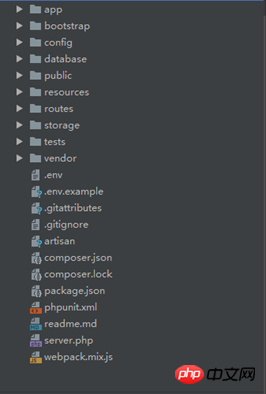Home >Backend Development >PHP Tutorial >The basics of Laravel learning
The basics of Laravel learning
- 不言Original
- 2018-07-04 14:14:092603browse
This article mainly introduces the basic knowledge about Laravel learning, which has certain reference value. Now I share it with everyone. Friends in need can refer to it
1.MVC Introduction
The full name of MVC is Model View Controller, which is the abbreviation of Model-View-Controller
Model is the part of the application used to process application data logic
View is the part of the application that processes data display
Controller is the part of the application that handles user interaction
2.laravel core directory file

app Contains the user's core code
booststrap contains framework startup and configuration loading files
config contains all configuration files
database contains database filling and migration files
public contains project entry and static resource files
resource contains views and original The resource file
stroage contains compiled template files as well as file-based session and file cache, log and framework files
tests unit tests File
wendor contains dependency files of compose
3. Routing
Multiple request routing
Route::match(['get', 'post']), 'match', funtion()
{
return 'match';
});
Route::any(['get', 'post']), funtion()
{
return 'any';
});Routing parameters
Route::get('user/{name}', funtion($name)
{
return $id;
})->where('name', '[A-Za-z]+');
Route::get('user/{id}/{name?}', funtion($id, $name='phyxiao')
{
return $id. $name;
})->where(['id' => '[0-9]+', 'name'=> '[A-Za-z]+']);Routing alias
Route::get('user/home', ['as' => 'home', funtion()
{
return route('home');
}]);Routing group
Route::group(['prefix' => 'user'], funtion()
{
Route::get('home', funtion()
{
return 'home';
});
Route::get('about', funtion()
{
return 'about';
});
});Routing output view
Route::get('index', funtion()
{
return view('welcome');
});4.Controller
Create control Device
php artisan make:controller UserController php artisan make:controller UserController --plain
Route associated controller
Route::get('index', 'UserController@index');
5. Model
php artisan make:model User
6. Database
Three ways:DB facode Raw lookup , Query Builder and Eloquent ORM
Related filesconfig/database.php, .env
Query constructor
$bool = DB::table('user')->insert(['name => phyxiao', 'age' => 18]);
$id = DB::table('user')->insertGetId(['name => phyxiao', 'age' => 18]);
$bool = DB::table('user')->insert([
['name => phyxiao', 'age' => 18],
['name => aoteman', 'age' => 19],
);
var_dump($bool);$num= DB::table('user')->where('id', 12)->update(['age' => 30]); $num= DB::table('user')->increment('age', 3); $num= DB::table('user')->decrement('age', 3); $num= DB::table('user')->where('id', 12)->increment('age', 3); $num= DB::table('user')->where('id', 12)->increment('age', 3, ['name' =>'handsome']);
$num= DB::table('user')->where('id', 12)->delete(); $num= DB::table('user')->where('id', '>=', 12)->delete(); DB::table('user')->truncate();
$users= DB::table('user')->get();
$users= DB::table('user')->where('id', '>=', 12)->get();
$users= DB::table('user')->whereRaw('id >= ? and age > ?', [12, 18])->get();
dd(users);
$user= DB::table('user')->orderBy('id', 'desc')->first();
$names = DB::table('user')->pluck('name');
$names = DB::table('user')->lists('name', 'id');
$users= DB::table('user')->select('id', 'age', 'name')->get();
$users= DB::table('user')->chunk(100, function($user){
dd($user);
if($user->name == 'phyxiao')
return false;
});$num= DB::table('user')->count(); $max= DB::table('user')->max('age'); $min= DB::table('user')->min('age'); $avg= DB::table('user')->avg('age'); $sum= DB::table('user')->avg('sum');
Eloquent ORM
// 建立模型
// app/user.php
<?php
namespace App;
use Illuminate\Database\Eloquent\Model;
class User extends Model
{
//指定表名
protected $table = 'user';
//指定id
protected $primaryKey= 'id';
//指定允许批量赋值的字段
protected $fillable= ['name', 'age'];
//指定不允许批量赋值的字段
protected $guarded= [];
//自动维护时间戳
public $timestamps = true;
protected function getDateFormat()
{
return time();
}
protected function asDateTime($val)
{
return val;
}
}// ORM操作
// app/Http/Contollers/userController.php
public function orm()
{
//all
$students = Student::all();
//find
$student = Student::find(12);
//findOrFail
$student = Student::findOrFail(12);
// 结合查询构造器
$students = Student::get();
$students = Student::where('id', '>=', '10')->orderBy('age', 'desc')->first();
$num = Student::count();
//使用模型新增数据
$students = new Student();
$students->name = 'phyxiao';
$students->age= 18;
$bool = $student->save();
$student = Student::find(20);
echo date('Y-m-d H:i:s', $student->created_at);
//使用模型的Create方法新增数据
$students = Student::create(
['name' => 'phyxiao', 'age' => 18]
);
//firstOrCreate()
$student = Student::firstOrCreate(
['name' => 'phyxiao']
);
//firstOrNew()
$student = Student::firstOrNew(
['name' => 'phyxiao']
);
$bool= $student->save();
//使用模型更新数据
$student = Student::find(20);
$student->name = 'phyxiao';
$student->age= 18;
$bool = $student->save();
$num = Student::where('id', '>', 20)->update(['age' => 40]);
//使用模型删除数据
$student = Student::find(20);
$bool = $student->delete();
//使用主见删除数据
$num= Student::destroy(20);
$num= Student::destroy([20, 21]);
$num= Student::where('id', '>', 20)->delete;
}7.Blade template engine
<!--展示某个section内容 占位符--> @yield('content', '内容') <!--定义视图片段--> @section(‘header’) 头部 @show
@extends('layouts')
@section(‘header’)
@parent
header
@stop
@section(‘content’)
content
<!--模板输出php变量-->
<p>{{$name}}</p>
<!--模板调用php代码-->
<p>{{ time() }}</p>
<p>{{ date('Y-m-d H:i:s', time()) }}</p>
<p>{{ in_array($name, $arr) ? 'true': 'false' }}</p>
<p>{{ $name or 'default' }}</p>
<!--原样输出-->
<p>@{{$name}}</p>
{{--模板注释--}}
{{--引入子视图--}}
@include('common', ['msg' => 'erro'])
{{--流控制--}}
@if ($name == 'phyxiao')
I'm phyxiao
@elseif($name == 'handsome')
I'm handsome
@else
none
@endif
@unless($name == 'phyxiao')
ture
@endunless
@for($i=0; $i < 10; $i++)
{{$i}}
@endfor
@foreach($students as $student)
{{$student->name}}
@endfor
@forelse($students as $student)
{{$student->name}}
@empty
null
@endforelse
<a herf = "{{url('url')}}">text</a>
<a herf = "{{action('UserController@index')}}">text</a>
<a herf = "{{route('url')}}">text</a>
@stopThe above is the entire content of this article, I hope it will be useful to everyone Learning is helpful. For more related content, please pay attention to the PHP Chinese website!
Related recommendations:
The above is the detailed content of The basics of Laravel learning. For more information, please follow other related articles on the PHP Chinese website!

